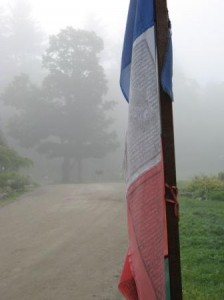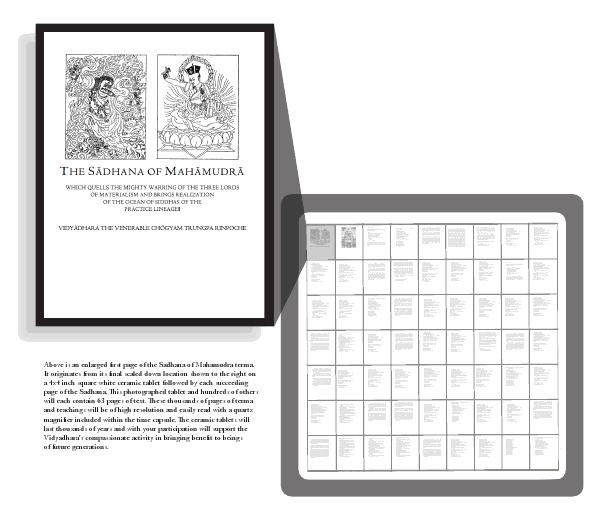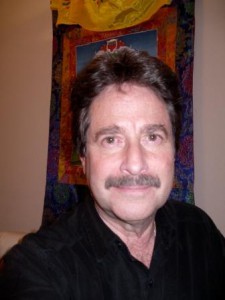Friday
Community Articles, Mandala ProjectsAn Elegantly Preserved Package
 Many of us in Shambhala harbor deeply inspired aspirations for what we would like to accomplish in the world. In this second article on the Shambhala Time Capsule, Jennifer Holder looks at the path Steve Roth followed in bringing the time capsule into being.
Many of us in Shambhala harbor deeply inspired aspirations for what we would like to accomplish in the world. In this second article on the Shambhala Time Capsule, Jennifer Holder looks at the path Steve Roth followed in bringing the time capsule into being.
At times, I reflect on the personal projects Shambhalians have brewing. Some among us were given direction or assignments from the Vidyadhara, others grow toward our aspirations under the empowering trust of Sakyong Mipham. Often, the projects seem large and daunting in the face of challenging conditions, and we cannot conceptually map out a plan to accomplish them. The veil of the future hides the means by which we will manifest our hearts.
In 1975, Steve Roth was given an assignment by the Vidyadhara, one that he held close for thirty-five years. He was given the daunting task of creating a time capsule that would last for 5,000 years. Containing the Shambhala teachings, it would be a “spiritual atomic bomb,” as the Vidyadhara said, that could awaken future societies – whether hundreds or thousands of years from now — to the possibility of basic sanity and a golden age.
I found Steve’s three-decade long journey fascinating — through study, disappointment, patience, perseverance, and coincidence, and now with the sangha’s help, this project can finally come to fruition in 2011. The time capsule will be ready to be placed under the Great Stupa of Dharmakaya.
How did he accomplish something that had no direct path to success and no clear solution to the challenges inherent in it? After interviewing him for this article, I found his path achingly familiar, and offer a sense of his path to fruition in the hopes that it will speak to what so many of us face on the road to genuine accomplishment.
Consulting the “Experts”
It often strikes us that the setting-sun world might offer solutions to our Shambhalian challenges, as we seek training, information, and practices that might help lay the foundations of enlightened society. It’s the first thing we think to do: Find someone who has done what we want to do and learn as much as we can from them. It may be – but is rarely the case — that we can ride on their coattails. The problem is often that what has been done before is infused with setting-sun mentality, conflicting theories and values, technology that only seems promising, and quick results that fade just as fast. Over the years, Steve corresponded at length with Westinghouse Corporation, the company responsible for two 5,000-year time capsules that have been buried as part of two New York World Fairs, and also with the director of another 5,000-year time capsule project at Oglethorpe University in Atlanta, Georgia. Steve was also given full access to scientists at the Smithsonian Institute. He was collaborating with the best minds in the world, only to find that their solutions didn’t withstand the Shambhalian measure.
Disappointment
One would think that the best minds from around the world would have figured out how to preserve something for 5,000 years, with their multi-million dollar budgets. Just as we assume that human society ever evolves forward, with the modern mentality being the most advanced. But the objects inside the capsule produced by Oglethorpe University had already showed signs of oxidation. The Westinghouse capsules may soon encounter oxidization problems, as many of their items are stored in separate oxygen-free glass “envelopes” that could easily crack in an earthquake, resulting in oxidization and corrosion. And the technology that was buried included machinery (such as a record player) with parts bound to corrode or confound those who uncover it. At the Smithsonian Institute, Steve found himself tangled in the scientists’ conflicting theories about whether it was plastic or metal that could last for 5,000 years. They presented Steve with no clear route by which to proceed. What Steve learned was that the “experts” had not yet figured it out.
The setting-sun is deceptive this way. Often, thinking I could rely on some insight or training developed by “the best of the best” of this world, I have been disappointed when I’ve held their results to Shambhala standards. In the end, I find that most often the fundamental inquiry was biased towards something, such as notoriety, financial reward, efficiency, or democratic ideals. And always, the heart of the matter is lost in complexity. Obviously, Steve didn’t have millions of dollars to invest in his own research and development department. And the simplicity of his vision could not give way to taking chances on unproved and ever-immutable technology.
But the gift of research and disappointment is that we learn what to discard, what to shed, what to leave behind, and what directions not to travel in. I’ve found that if we allow for disappointment and the resultant reflection, rather than forging arrogantly ahead at all costs, we learn a great deal about how our project fits into the world. We learn about conditions that we never could have before anticipated, we refine the forms our aspirations take, and align them ever further with Shambhala vision and view.
 Patience
Patience
Meeting with disappointment, over and over again, takes great patience. Having lived with this mission for three decades, one can only wonder at what Steve went through during the years. Alternately letting go of the project, returning to contemplate or investigate, and once again letting go of it. This is clear – he held the vision steady in his heart, through ups and downs, steps forward and back, all pointing to faith in the invisible, the mysterious and magical. He held to the Shambhala principles of meek — not leaping to soon, of waiting and observing, learning and discarding the excess, of returning to the conditions that surrounded his endeavor. The veils that obscure all our minds raised and lowered again, and again, and again. While frustrating and ever-baffling, these veils actually act in our favor, for they only lift when the conditions are ripe for fruition. And we can trust in our stumbling forward and not-knowing, because as we move towards something our vision of the greater situation at hand gets larger and larger as we learn of both the limitations and potentials we weren’t previously aware of. As we continue, we let die what we hold on to only to experience an ever-refreshed and up-to-date relationship with the project. Through these disappointments, our understanding of our world actually expands.
Coincidence
The challenge we all face, in every moment and especially in the face of disappointment, is not to close down. While always mutable in form, what we discover is that the aspiration itself can be diamond-like, carried unchanging as time passes. We can wait, unhurried, patiently, and with great faith, for conditions to be right. In Steve’s case, it was a chance meeting that led to the time capsule’s fruition. Steve mentioned it to a neighbor, who introduced Steve to a brilliant local scientist and technological guru with an ongoing interest in long-term preservation, named John Marshall. John was responsible for the design of the long-term containment vessel for the skull relic of the Vidyadhara. The molecular sieve that he installed just beneath the skull relic will absorb all residual moisture, ensuring that the relic will remain as it is hundreds of years from now.
An Elegant Solution
The dilemma that Steve and John held was to not only find a material to use for the thousand upon thousands of pages of text by the Vidyadhara and Sakyong Mipham that would withstand 5,000 years being buried, but also not being tricked into thinking that the people of the future will be able to use technology to access it. What was needed was typically Shambhalian – something natural and elegant, something that provided an elemental and intuitively usable format beyond the current digitally obsessed world.
When Steve handed me a text-inscribed ceramic tile prototype, I sensed that he had indeed arrived at an elegant solution. Ceramic is eternally durable – we know that from the ancient and beautiful Asian vases we see in museums and the discovery of the Chinese Terracotta Warriors. It is composed of grains of sand, so that – like sand on a beach – it remains unchanged. A refined level of technology, interestingly, is needed for transferring the pages of text onto the ceramic tiles. Each four inch square tile will have 63 pages of miniaturized text on it. I found the text to be incredibly crisp when viewed with the crystal magnifier Steve provided.
This utter simplicity, which while requiring complex technology to accomplish, provides a reading experience that needs no explanation or device other than magnification. Steve had the patience to await the arrival of an elegant solution.
Click on the tile to enlarge it.
The text in the image reads: Above is an enlarged 1st page of the Sadhana of Mahamudra terma. It originates from its scaled-down location shown to the right on a 4×4 inch square white ceramic tablet followed by each succeeding page of the Sadhana. This photographed tablet and hundreds of others will each contain 63 pages of text. These thousands of pages of terma
and teachings will be of high resolution and easily read with a quartz magnifier included within the time capsule. The ceramic tablets will last thousands of years and with your participation will support the Vidyadhara’s compassionate activity in bringing benefit to beings of future generations.
Click here for the third article in this series.
To donate, kindly follow this link to the Time Capsule page on the Sakyong Foundation website. Click on the red “Donate Now” button on the right side of that page. You can then choose your method of payment. Please select “Time Capsule Project” in the Donation Purpose field.
Steve Roth met the Vidyadhara Chogyam Trungpa Rinpoche in London in 1968 and has been his student since 1970. Steve is a member of the Shambhala sangha and lives in Boulder, Colorado. If you have any questions, comments, or would like more information, you can contact Steve Roth by email: [email protected]







Dec 6, 2010
Reply
What a brilliant solution for recording and sharing the Vidyadara’s dharma with the 250th generation. I love it. Well done Steve!
All the best,
Bruce